

Sauter mean diameter. In fluid dynamics, Sauter mean diameter (SMD, d32 or D[3, 2]) is an average of particle size.
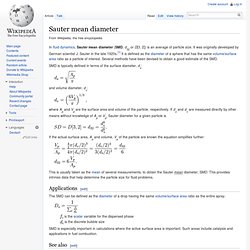
It was originally developed by German scientist J. Sauter in the late 1920s.[1] It is defined as the diameter of a sphere that has the same volume/surface area ratio as a particle of interest. Several methods have been devised to obtain a good estimate of the SMD. SMD is typically defined in terms of the surface diameter, ds: and volume diameter, dv: where Ap and Vp are the surface area and volume of the particle, respectively. If the actual surface area, Ap and volume, Vp of the particle are known the equation simplifies further: This is usually taken as the mean of several measurements, to obtain the Sauter mean diameter, SMD: This provides intrinsic data that help determine the particle size for fluid problems.
Applications[edit] The SMD can be defined as the diameter of a drop having the same volume/surface area ratio as the entire spray. Stationary Gas Turbines. AMMONIUM CARBAMATE. Formula: NH2COONH4; MW 78.07; Synonyms: ammonium aminoformate; ammonium carbonate anhydride Uses Ammonium carbamate is used as an ammoniating agent.
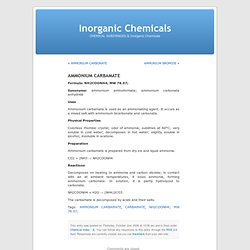
It occurs as a mixed salt with ammonium bicarbonate and carbonate. Physical Properties Colorless rhombic crystal; odor of ammonia; sublimes at 60°C; very soluble in cold water; decomposes in hot water; slightly soluble in alcohol; insoluble in acetone. Preparation Ammonium carbamate is prepared from dry ice and liquid ammonia: Reactions Decomposes on heating to ammonia and carbon dioxide; in contact with air at ambient temperatures, it loses ammonia, forming ammonium carbonate.
The carbamate is decomposed by acids and their salts. Ammonium hydroxide - Aqueous ammonia. Ammonia solution, also known as ammonium hydroxide, ammonia water, ammonical liquor, ammonia liquor, aqua ammonia, aqueous ammonia, or simply ammonia, is a solution of ammonia in water.
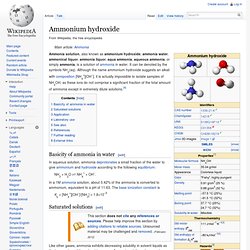
It can be denoted by the symbols NH3(aq). Although the name ammonium hydroxide suggests an alkali with composition [NH4+][OH−], it is actually impossible to isolate samples of NH4OH, as these ions do not comprise a significant fraction of the total amount of ammonia except in extremely dilute solutions.[4] Basicity of ammonia in water[edit] In aqueous solution, ammonia deprotonates a small fraction of the water to give ammonium and hydroxide according to the following equilibrium: In a 1M ammonia solution, about 0.42% of the ammonia is converted to ammonium, equivalent to a pH of 11.63.
Kb = [NH4+][OH−]/[NH3] = 1.8×10−5 Saturated solutions[edit] Application[edit] In industry, ammonium hydroxide is used as a precursor to some alkyl amines, although anhydrous ammonia is usually preferred. Urea. Urea or carbamide is an organic compound with the chemical formula CO(NH2)2.
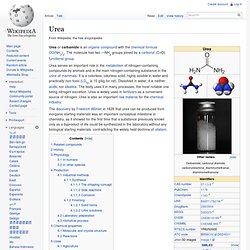
The molecule has two —NH2 groups joined by a carbonyl (C=O) functional group. The discovery by Friedrich Wöhler in 1828 that urea can be produced from inorganic starting materials was an important conceptual milestone in chemistry, as it showed for the first time that a substance previously known only as a byproduct of life could be synthesized in the laboratory without any biological starting materials, contradicting the widely held doctrine of vitalism. Related compounds[edit] The terms urea is also used for a class of chemical compounds sharing the same functional group RR'N—CO—NRR', namely a carbonyl group attached to two organic amine residues. Examples include carbamide peroxide, allantoin, and hydantoin. History[edit] Urea was first discovered in urine in 1727 by the Dutch scientist Herman Boerhaave,[3] though this discovery is often attributed to the French chemist Hilaire Rouelle.[4] Ammonium carbonate. Ammonium carbonate is a salt with the chemical formula (NH4)2CO3.
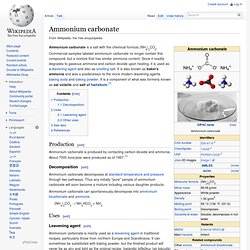
Commercial samples labeled ammonium carbonate no longer contain this compound, but a mixture that has similar ammonia content. Since it readily degrades to gaseous ammonia and carbon dioxide upon heating, it is used as a leavening agent and also as smelling salt. It is also known as baker's ammonia and was a predecessor to the more modern leavening agents baking soda and baking powder.